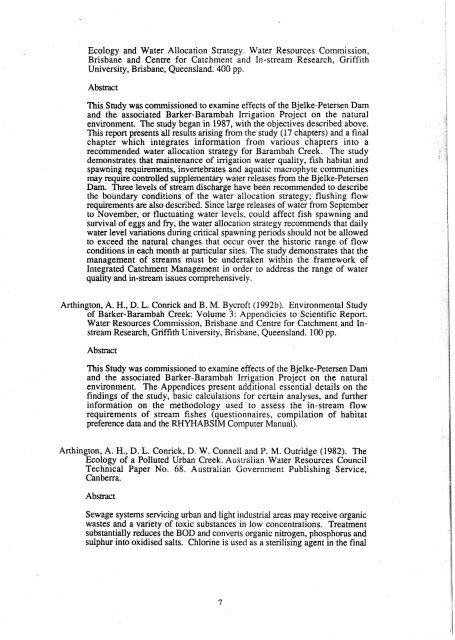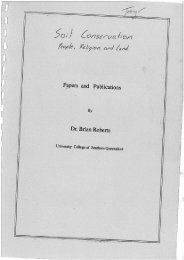annotated-bibliography-literature-condition ... - South West NRM
annotated-bibliography-literature-condition ... - South West NRM
annotated-bibliography-literature-condition ... - South West NRM
Create successful ePaper yourself
Turn your PDF publications into a flip-book with our unique Google optimized e-Paper software.
Ecology and Water Allocation Strategy. Water Resources Commission,<br />
Brisbane and Centre for Catchment and In-stream Research, Griffith<br />
University, Brisbane, Queensland. 400 pp.<br />
Abstract<br />
This Study was commissioned to examine effects of the Bjelke-Petersen Dam<br />
and the associated Barker-Barambah Irrigation Project on the natural<br />
environment. The study began in 1987, with the objectives described above.<br />
This report presents all results arising from the study (17 chapters) and a final<br />
chapter which integrates information from various chapters into a<br />
recommended water allocation strategy for Barambah Creek. The study<br />
demonstrates that maintenance of imgation water quality, fish habitat and<br />
spawning requirements, invertebrates and aquatic macrophyte communities<br />
may require controlled supplementary water releases from the Bjelke-Petersen<br />
Dam. Three levels of stream discharge have been recommended to describe<br />
the boundary <strong>condition</strong>s of the water allocation strategy; flushing flow<br />
requirements are also described. Since large releases of water from September<br />
to November, or fluctuating water levels, could affect fish spawning and<br />
survival of eggs and fry, the water allocation strategy recommends that daily<br />
water level variations during critical spawning periods should not be allowed<br />
to exceed the natural changes that occur over the historic range of flow<br />
<strong>condition</strong>s in each month at particular sites. The study demonstrates that the<br />
management of streams must be undertaken within the framework of<br />
Integrated Catchment Management in order to address the range of water<br />
quality and in-stream issues comprehensively.<br />
Arthington, A. H., D. L. Conrick and B. M. Bycroft (1992b). Environmental Study<br />
of Barker-Barambah Creek: Volume 3: Appendicies to Scientific Report.<br />
Water Resources Commission, Brisbane and Centre for Catchment and Instream<br />
Research, Griffith University, Brisbane, Queensland. 100 pp.<br />
Abstract<br />
This Study was commissioned to examine effects of the Bjelke-Petersen Dam<br />
and the associated Barker-Barambah Irrigation Project on the natural<br />
environment. The Appendices present additional essential details on the<br />
findings of the study, basic calculations for certain analyses, and further<br />
information on the methodology used to assess the in-stream flow<br />
requirements of stream fishes (questionnaires, compilation of habitat<br />
preference data and the RHYHABSIM Computer Manual).<br />
Arthington, A. H., D. L. Conrick, D. W. Connell and P. M. Outridge (1982). The<br />
Ecology of a Polluted Urban Creek. Australian Water Resources Council<br />
Technical Paper No. 68. Australian Government Publishing Service,<br />
Canberra.<br />
Abstract<br />
Sewage systems servicing urban and light industrial areas may receive organic<br />
wastes and a variety of toxic substances in low concentrations. Treatment<br />
substantially reduces the BOD and converts organic nitrogen, phosphorus and<br />
sulphur into oxidised salts. Chlorine is used as a sterilising agent in the final

















